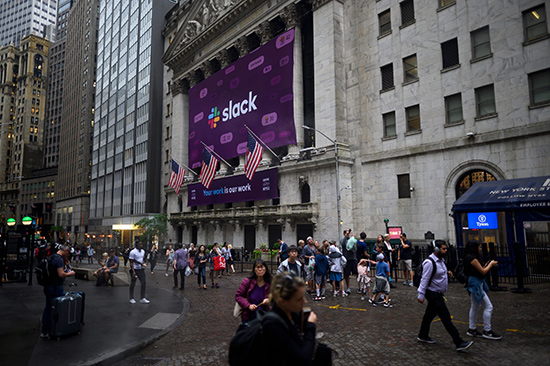科技獨角獸已經死了?太夸張了

|
對科技行業(yè)里某些曾經被夸上天的獨角獸來說,今年一直紛亂不安,。 在上市新股走勢欠佳(像Lyft和Uber)以及IPO表現糟糕之際(比如WeWork),,判斷2019年會不會出現泡沫破裂算不上什么難事,而這個泡沫就出現在科技公司的身上,,它曾經把投資者旺盛的胃口變成了極為膨脹而且不受控制的私募估值,。 但在高盛的科技投行業(yè)務主管看來,對打算涉足資本市場的科技公司來說,,負面新聞掩蓋了依然良好的環(huán)境,。 高盛的全球科技、傳媒和電信(TMT)集團負責人尼克·喬瓦尼對《財富》雜志表示:“有幾家非上市公司這幾年過的很難,,但獨角獸就要死亡的報道有些言過其實,。” 喬瓦尼指出,,美國的科技公司上市規(guī)模已經連續(xù)四年上升,,而且他預計這樣的勢頭將延續(xù)到2020年。他說:“這兩年我們一直在說出現了‘超大周期’,,現在我們正處于其中。我覺得2020年將成為科技公司IPO市場連續(xù)擴張的第五個年頭,?!?/p> 去年的一大特點是私募估值數百億美元的科技寵兒發(fā)現股市中的日子可能并不好應付,,這里還會強調透明度和對股東的責任。但喬瓦尼說這種“成長的煩惱”對較年輕的公司來說并不是什么新鮮事,,而且不斷擴大的未上市初創(chuàng)公司群體仍然會設法上市,。 他說:“確實有一些知名公司上市后的表現并不好,還有些高調的[未上市公司]價值縮水,,但這并非新的現象,。在這個階段,股市必須學習怎樣對私募[估值]基準較高的公司進行估值和交易,,學習怎樣交易直接上市的股票,。我們對這些趨勢持有樂觀態(tài)度?!?/p> 公司上市新途徑 說到直接上市,,喬瓦尼認為資本市場已經發(fā)現了在他看來可以延續(xù)的“創(chuàng)新”。高盛為今年夏天直接上市的Slack提供了顧問服務,,這家協同辦公軟件公司跟隨著Spotify(2018年直接上市)的腳步,,選擇了一條到目前為止仍不尋常的路徑。 直接上市模式允許公司將投資者持有的已發(fā)行股份拿到公開交易所中,,而不是像IPO那樣為自身股票的交易而發(fā)行新股,。直接上市的公司繞開了承銷商等中介機構,也避免了已有股份被稀釋,。 當然,,直接上市模式也有局限性,比如無法通過發(fā)行新股來籌集資金,。喬瓦尼說這已經讓“需要融資”的擬上市公司望而卻步,。但這種情況有可能就要發(fā)生改變,因為11月26日有報道稱紐約證券交易所已經向聯邦監(jiān)管部門提交申請,,打算允許公司通過直接上市融資,。 喬瓦尼補充說,無論此舉能否避開高額承銷費,,或者能否讓投資者得以套現,,和以前相比,“考慮直接上市的公司都要多得多”,,而且2020年通過這種途徑上市的公司數量也會有顯著增長,。 他認為,直接上市模式出現后還有可能成為一個跳板,,從而“讓今后的公司找到新的上市方法”,,而且投資銀行、監(jiān)管部門和交易商一直在探討讓公司獲得資金的潛在新途徑。 并非只有消費科技 雖然Pinterest和Peloton等面向消費者的公司吸引了股市的很大一部分注意力,,但恢復活力的企業(yè)軟件行業(yè)在2019年同樣名聲大噪,,CloudStrike、Cloudflare,、Dynatrace和Zoom等公司都通過IPO獲得了資金,。 喬瓦尼說:“我們發(fā)現,達到較大規(guī)模的企業(yè)軟件公司數量有了迅猛增長”,,這源于“企業(yè)軟件在開發(fā)和銷售方面的創(chuàng)新”,。他還指出,隨著企業(yè)技術需求的演變以及公司為其安裝的軟件投入更多資源,,“我們預計這個趨勢將延續(xù)下去”,。 私募資金依然強勢 與此同時,雖有人擔心過多的泡沫不利于實際投資環(huán)境,,但私募市場仍然在向前邁進,。 高盛的研究顯示,美國風險投資人通過徹底退出獲得的回報在2019年首次突破2000億美元,。此外,,他們的“彈藥”也比以往任何時候都充足。高盛引用企業(yè)統(tǒng)計機構PitchBook的數據稱,,美國和歐洲風投公司尚未使用的資金達到了創(chuàng)紀錄的1440億美元,。 當然,高盛的研究還發(fā)現,,今年風投的融資步伐明顯放慢,,2019年關閉的基金數量及其籌集的資金規(guī)模都低于近期的歷史高點。由于軟銀還沒有完全擺脫WeWork崩盤的不利影響,,也有人高度懷疑私募價值能否準確地體現公司的發(fā)展前景,。 喬瓦尼承認:“公司的重點是不計代價地擴張以及謀劃未來的融資能力,從這個角度講,,投資者和公司都有所退出,。” 但由于許多私募投資者仍然通過漂亮地退出而獲得了高額收益,,他相信私募市場“仍在非常順利地運轉”,。 喬瓦尼說:“支持頂尖公司的資金非常多,可以幫它們起步并擴大規(guī)模,。我們在過去一年中看到私募創(chuàng)造出了巨大的價值,。”(財富中文網) 譯者:Charlie 審校:夏林 |
It’s been a tumultuous year for some of the tech sector’s once vaunted unicorns. With underwhelming public market debuts (see: Lyft and Uber) and botched IPOs (a la WeWork), it’s hardly a stretch to wonder whether 2019 saw the bursting of a bubble—one characterized by tech firms that had parlayed robust investor appetite into grossly inflated, runaway private valuations. But according to Goldman Sachs’ top tech investment banker, negative headlines have overshadowed what continues to be a strong environment for tech firms looking to tap the capital markets. “A handful of private companies had difficult years, but the reports of dying unicorns are greatly exaggerated,” Nick Giovanni, head of the global technology, media, and telecom (TMT) group at Goldman Sachs, told Fortune. Giovanni cited what’s been a fourth consecutive year of growth in U.S.-listed IPO volume by tech companies—a dynamic that he expects to continue going into 2020. “We’re in the middle of what we’ve been talking about for two years as a ‘megacycle,’” he noted. “I’d expect 2020 to be the fifth year in a row of growth in the tech IPO market.” This past year was marked by tech darlings with private valuations in the tens of billions of dollars finding that life on the public markets—complete with heightened transparency and accountability to shareholders—can be a tricky proposition. But Giovanni says such growing pains are nothing new for relatively young companies, and pointed to an ever-larger backlog of private startups that will still look to go public. “There were certainly some high-profile companies that went public and did not trade well, and some high-profile [private] write-downs, but that’s not a new phenomenon,” he says. “This is a period where the public markets are having to learn how to value and trade companies with private [valuation] benchmarks that are higher, and learn how to trade direct listings. We’re optimistic about these trends.” New ways for companies to go public With direct listings, Giovanni thinks the capital markets have found an “innovation” that he believes is here to stay. Goldman Sachs advised Slack on its direct listing this past summer, with the workplace software firm following Spotify (which went public via direct listing in 2018) in pursuing a heretofore unconventional route. The direct listing model allows companies to list existing shares held by investors on a public exchange—rather than offering new shares for trading, as is done in an IPO. It allows them to bypass intermediaries such as underwriters, and also avoids the dilution of the company’s existing stock. Of course, there are limitations to the direct listing model—such as an inability to raise money via offering new shares—which have dissuaded companies “that need to raise capital” in their public forays, Giovanni said. But that could be set to change, with November 26’s news that the New York Stock Exchange has filed paperwork with federal regulators seeking to allow companies to raise fresh capital via direct listings. Whether it’s avoiding hefty underwriting fees or granting investors the ability to cash out shares, Giovanni added that “many more companies are considering direct listings” than before, and will pursue them as an avenue to going public in 2020. The emergence of the direct listing model could also prove a jumping off point to “find[ing] new ways for companies to go public” in the future, he noted—with investment banks, regulators and exchanges continuing to discuss new potential paths for companies to access capital. Not just consumer tech While consumer-facing companies like Pinterest and Peloton grabbed much of the attention on the public markets, a resurgent enterprise software sector had a banner year in 2019—with the likes of CloudStrike, Cloudflare, Dynatrace, and Zoom all capitalizing via IPOs of their own. “We have seen a tremendous growth in the number of enterprise software companies achieving larger scale,” Giovanni said, attributing that growth to “innovations in the way that enterprise software is developed and distributed.” With businesses’ technological demands evolving and companies pouring more resources into the software they deploy, “we see that trend continuing,” he added. Private funding still strong The private financing markets, meanwhile, continue to roll on despite concerns that the investment environment has proven too frothy for its own good. U.S. venture capital investors saw their bets rewarded with more than $200 billion in total exits for the first time in 2019, according to Goldman Sachs research. What’s more, there’s more dry powder out there than ever; U.S. and European VCs are holding a record $144 billion in uninvested capital, according to PitchBook data cited by Goldman. Of course, the bank’s research also notes that VC fundraising slowed down notably this year, with fewer funds closed and less money raised in 2019 compared to recent record levels. And with SoftBank still wiping the egg off its face from the WeWork debacle, there’s heightened skepticism about whether private valuations are an accurate barometer of a company’s prospects. Giovanni acknowledges that “to the extent that companies were focused on scaling at all costs and planning on the ability to raise money in the future, you’ve seen investors and companies pull back a small amount.” But with many private investors continuing to generate strong returns thanks to robust exits, he believes the private markets “are still functioning very well.” “There is a lot of capital to support great companies, to help them start and scale,” he says. “We’ve seen a significant amount of private value creation over the course of the last year.” |













